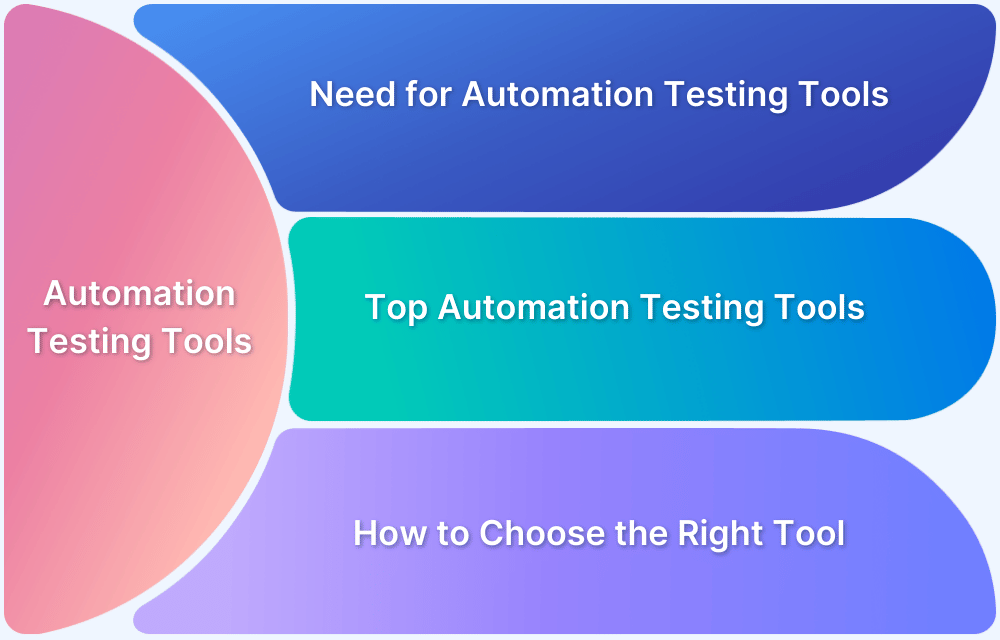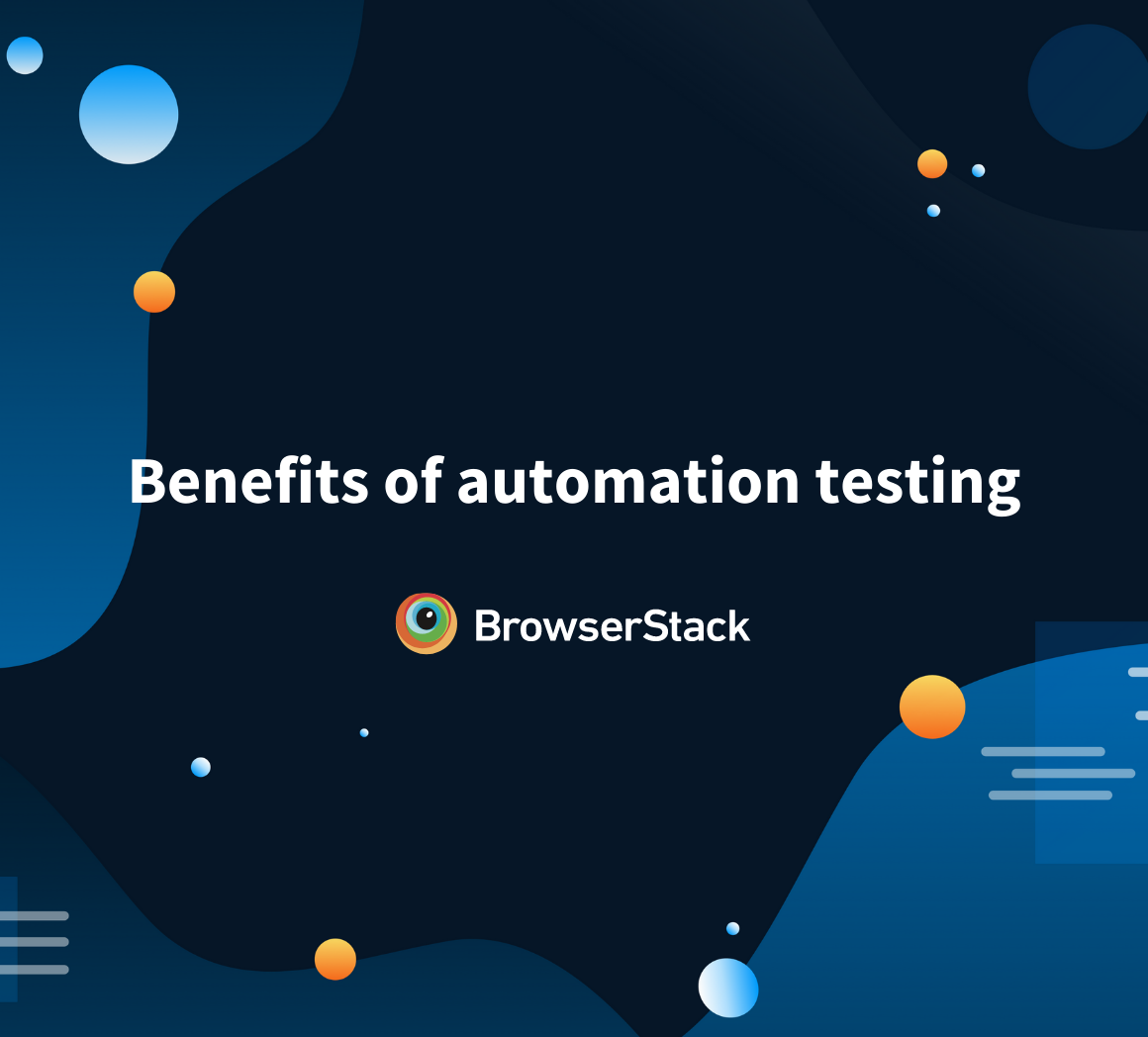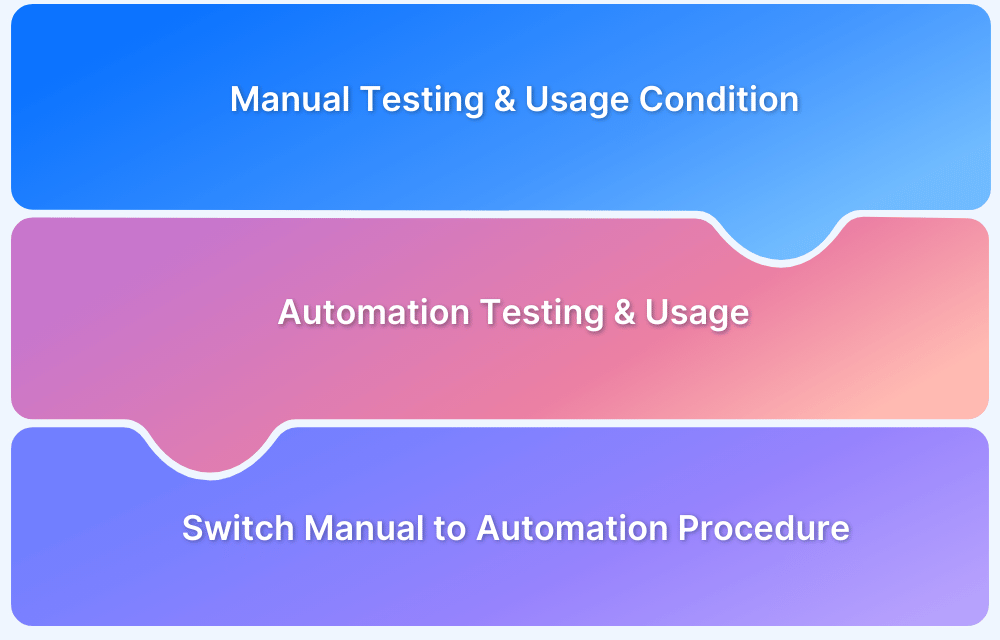Backend Automation Testing Tools
By Shweta Jain, Community Contributor - October 17, 2024
Backend testing is essential for evaluating software’s server-side components, such as databases, APIs, and server logic. This process ensures that data processing, storage, and retrieval function correctly and efficiently.
Backend testing helps ensure that the system operates reliably and meets user expectations by identifying potential issues that could impact data integrity, performance, and security.
Backend automation tools help users mitigate risks like data breaches and ensure reliable operation, protecting both their business and users.
- What is Backend Testing?
- Why should you Automate Backend Testing?
- What are Backend Automation Testing Tools?
- What are the Benefits of Backend Automation Testing Tools?
- Types of Backend Testing
- Top Backend Automation Testing Tools
- 1. BrowserStack Automate
- 2. Hypertest
- 3. Selenium
- 4.Cypress
- 5. Postman
- 6. HammerDB
- 7. Parasoft
- 8. Tricentis Tosca
- 9. Playwright
- 10.JMeter
What is Backend Testing?
Backend testing is the process of verifying and validating the server-side components of a software application.
Unlike frontend testing, which focuses on the user interface, backend testing ensures that the server, database, APIs, and other server-side elements function correctly. It aims to test the logic, processes, and data handling behind the scenes to ensure data integrity, security, and performance.
Why should you Automate Backend Testing?
Automating backend testing saves time and boosts efficiency by executing tests quickly and consistently, ensuring comprehensive coverage. It enables early detection of issues in the development cycle, reducing the risk of defects later.
Moreover, automation allows for easy test reusability and integration into CI/CD pipelines, streamlining the development process. This leads to faster releases and improved software quality, making it a critical component of modern development practices.
What are Backend Automation Testing Tools?
Backend automation testing tools are software applications designed to automate the testing of server-side components, databases, and APIs. They automate the efficient execution of test cases, validating data integrity, performance and functionality.
These tools help streamline testing processes, enhance coverage for quick detection of issues and integration into CI/CD pipelines. They make sure the backend is robust and on its toes for whatever the frontend throws its way maximizing improved software quality and minimizing the risk of performance.
What are the Benefits of Backend Automation Testing Tools?
Backend Automation Testing Tools offer several key benefits, such as:
- Automating repetitive tasks
- Delivering consistent results
- Scaling tests as the application grows without increasing resources
- Enabling early defect detection within CI/CD pipelines.
Read More: Benefits of Automation Testing
Types of Backend Testing
Backend testing involves various methodologies to validate the robustness, functionality, and security of server-side components. These include:
Structural Testing
Structural testing focuses on the internal workings of the backend, examining the code, architecture, and data flow to ensure it meets design specifications.
Functional Testing
Functional testing focuses on whether the software behaves and functions as intended. Here are several types of functional testing:
- Regression Testing: Verifies that new changes haven’t impacted existing functionalities.
- Unit Testing: Validates the correctness of individual components, any specific logic, etc.
- Sanity Testing: Checks specific functionalities after changes to ensure they work as per requirement.
- Smoke Testing: Conducts a first-level test to ensure the basic features of the backend are functioning.
- Integration Testing: Ensures that different backend components or systems work together as expected.
- Usability Testing: Evaluates how simple and user-friendly the backend interfaces are for users.
Non Functional Testing
Non Functional testing checks how the backend performs under various conditions rather than verifying specific functionalities.
- Load Testing: Tests the backend under anticipated loads to ensure stability.
- Performance Testing: Evaluates response times, output and resource occupancy
- Security Testing: Identifies vulnerabilities and facilitates the security measures of the backend to safeguard against potential threats.
Top Backend Automation Testing Tools
Here is the list of top Backend Automation Testing Tools to consider:
1. BrowserStack Automate
BrowserStack Automate is a cloud-based platform enabling automated cross-browser testing and cross-device testing. It allows developers and testers to run Selenium, Appium, and JavaScript-based tests on a cloud grid of over 3500 real devices and browsers.
It integrates flawlessly with CI/CD pipelines, providing real-time debugging, logs, and parallel test execution.
Key Features:
- It provides over 3500+ real browsers and devices and also supports Cross-browser & device testing
- Runs multiple tests simultaneously to speed up testing.
- Performs end-to-end testing to validate full software workflows on real devices for accuracy.
- Integrates with popular CI tools like Jenkins, CircleCI, Travis CI, etc.
- Provides debugging capabilities with screenshots, logs, and video recording of test executions.
- Replicates network conditions like 3G, 4G, or low bandwidth to test connectivity and latency.
- View test reports in real-time with rich insights.
Pros:
- Extensive device/browser coverage for accurate cross-platform testing.
- Excellent integration with CI/CD pipelines.
- Comprehensive debugging tools with video logs.
2. Hypertest
Hypertest is a smart test execution platform designed to drastically reduce test execution time using AI and machine learning by analyzing code changes and running only relevant tests.
This approach optimizes resource usage and boosts testing efficiency, helping teams catch issues faster. By integrating seamlessly into CI/CD pipelines, Hypertest ensures that your testing process is both efficient and adaptive, making it ideal for fast-paced development environments.
Key Features:
- Uses AI to identify test scenarios and run only relevant tests.
- Fast execution by distributing tests across multiple machines.
- Works well with most CI/CD Integration systems.
- Test case prioritization to optimize execution time.
- Scales up test execution across multiple environments.
Pros:
- Less test execution time.
- Efficient use of resources by running only necessary tests.
Cons:
- Limited market presence; lacks widespread community support.
- Requires initial setup to integrate AI algorithms into existing systems.
Read More: Best Automation Testing Tools
3. Selenium
Selenium is the most popular open-source automation test framework for testing web browsers across different browsers and platforms.
Known for its versatility, Selenium allows testers to automate browser interactions and verify web app functionality with ease. With support for multiple programming languages, Selenium is a favorite among developers who require robust cross-browser testing and integration with various tools.
Key Features:
- It supports all modern browsers (Chrome, Firefox, Safari, etc.) and cross-browser testing.
- Users can write scripts in multiple languages, such as Java, Python, Ruby, etc.
- Run tests in parallel across different browsers and machines.
- Active community support with plenty of plugins and integrations.
Pros:
- Free and open-source.
- Extremely flexible with multi-language support.
- Cross-browser and cross-platform testing.
Cons:
- Requires good programming knowledge, making it challenging for beginners.
- Lacks reporting tools, requiring third-party integrations for detailed reports.
- Frequent maintenance is required due to UI changes.
- Limited to web application testing.
- Requires tools like Appium for mobile apps.
- Complicate test scripts
4.Cypress
Cypress is a modern end-to-end testing framework primarily focused on developers and QA engineers. Unlike traditional testing tools, Cypress operates within the browser, providing real-time feedback as tests run.
Its JavaScript-friendly design makes it perfect for modern web applications, enabling fast, reliable tests and easy debugging with automatic retries and snapshots.
Key Features:
- Fast and reliable tests run directly in the browser.
- No need for manual waits; it retries automatically.
- Take snapshots during test execution for easier debugging.
- Test execution updates in real-time.
- Friendly API with a comprehensive dashboard.
Pros:
- Best suited for JavaScript and modern web applications.
- Fast test execution.
- Developer-friendly with great debugging tools.
Cons:
- Limited to web applications; no mobile or desktop app support.
- Lesser browser support compared to Selenium.
5. Postman
Postman is a powerful tool for API testing and development that simplifies API workflows with a user-friendly interface. It allows users to create, share, and automate API tests with ease, making it ideal for team collaboration.
With support for manual and automated testing, Postman is versatile enough to handle the entire API lifecycle from development to monitoring.
Key Features:
- API lifecycle management can easily be managed as it develops, tests, and monitors APIs.
- Automate API tests with Newman, the command-line companion.
- Share API collections and environments within teams.
- Create mock APIs for development and testing.
- Generate and share Comprehensive API documentation.
Pros:
- Excellent for API testing with quick collaboration.
- Comprehensive features for API lifecycle management.
Cons:
- Not suitable for full end-to-end automation (e.g., web and UI testing).
- Advanced features require paid plans.
6. HammerDB
HammerDB is an open-source tool for database benchmarking and load testing, supporting databases like Oracle, MySQL, and PostgreSQL.
It enables users to simulate complex database workloads, making it a good choice for stress testing and performance analysis. With GUI and CLI modes, HammerDB offers flexibility for both beginners and advanced users who need to assess database capabilities under heavy loads.
Key Features:
- Support for multiple and popular databases like Oracle, MySQL, etc.
- Create sophisticated workloads in Workload simulation to stress test your databases.
- Supports both GUI and CLI modes.
- Simulate large numbers of users to test database performance.
Pros:
- Free and open-source.
- Cross-database support for comprehensive testing.
Cons:
- Requires a good understanding of database systems.
- Limited UI testing capabilities.
7. Parasoft
Parasoft offers an enterprise-grade automated testing platform focused on API testing, service virtualization, and functional testing.
Its extensive testing capabilities make it suitable for complex application architectures, providing automated testing for REST, SOAP, and other services. Parasoft’s service virtualization allows teams to simulate third-party services, helping to isolate testing and ensure accurate results.
Key Features:
- Automate end-to-end testing for REST, SOAP, and other services.
- Simulate third-party services for testing.
- Integrated support for unit and functional tests.
- Comprehensive support for automation and CI/CD
Pros:
- A comprehensive enterprise solution with broad testing capabilities.
- Service virtualization for isolated testing.
Cons:
- Has a steep learning curve for new users.
8. Tricentis Tosca
Tricentis Tosca is an enterprise-grade test automation tool offering codeless test creation for web, desktop, and mobile applications.
Its intuitive, codeless interface enables non-technical users to create automated tests, making it accessible for broader teams. By supporting multiple testing types and integrating with CI/CD tools, Tosca facilitates continuous testing across diverse platforms.
Key Features:
- Tricentis Tosca is a codeless, easy-to-use interface.
- Seamlessly integrates with popular CI/CD tools.
- Supports web, mobile, API, and database testing. Users can perform end-to-end testing
- Prioritizes risk-based testing
Pros:
- Codeless interface; ideal for non-programmers.
- Supports multiple testing types (functional, performance, etc.).
Cons:
- Limited flexibility for customized test scripting.
9. Playwright
Playwright is an open-source test automation tool developed by Microsoft that allows developers to simulate interactions across browsers in a single API.
Known for its speed and browser coverage, Playwright offers cross-browser testing for Chrome, Firefox, Safari, and Edge. With multi-language support and headless mode for faster execution, Playwright is a powerful choice for teams focused on cross-browser compatibility.
Key Features:
- It supports cross-browser testing on Chrome, Firefox, Safari, and Edge.
- Provides multi-language support and works seamlessly with JavaScript, Python, C#, and more.
- Run tests in headless mode for fast execution.
- Run tests in isolated browser contexts.
Pros:
- Powerful and fast, with great browser coverage.
- Built-in support for multiple programming languages.
Cons:
- Steeper learning curve than Cypress for beginners.
- Fewer integrations with legacy browsers.
10.JMeter
Apache JMeter is a versatile and open-source tool for load and performance testing of web apps, APIs, and services.
It can simulate high user traffic to measure systems’ performance, scalability, and reliability under various conditions. With support for numerous protocols and extensive plug-in options, JMeter is a highly flexible tool ideal for load testing large-scale applications.
Key Features:
- Simulates high user traffic to measure server performance.Good for Load & Performance Testing,
- Supports HTTP, HTTPS, FTP, JDBC, SOAP, REST, and more protocols.
- Use the graphical interface or run tests headlessly via the command line.
- Plug-in support and integration with CI/CD tools for automation.
- Generates detailed performance test reports with metrics like response times, output, and errors.
Pros:
- Open-source and free to use.
- Comprehensive protocol support.
- Easily extensible with plug-ins and supports integration with CI tools.
Cons:
- High memory consumption with large-scale tests.
- Has a steeper learning curve for complex configurations.
- Limited support for modern UI-based testing.
Why perform Backend Automation Testing on Real Devices with BrowserStack?
Performing backend automation testing on real devices with BrowserStack Automate ensures accurate results by testing in real-world conditions, reduces defects, and enhances user experience across a range of devices and environments.
- Test under real user conditions: Testing on real devices ensures you catch those elusive bugs with BrowserStack that emulators conveniently ignore, like that one crash in the application.
- Parallel Testing: Maximize your testing speed by running multiple tests simultaneously across various devices, saving time and boosting efficiency.
- Network Simulations: Replicate real-world network conditions like 3G,4G or low bandwidth with browserstack to test how your app handles poor connectivity, latency, and interruptions.
- End-to-end Testing: Validate every part of your app’s workflow from backend automation with front-end tests by testing the entire user journey on real devices for complete accuracy.
- Local Testing: Test staging environments and localhost setups on real devices to catch issues before they go live
- Real Device Cloud: Access a wide range of real devices on the cloud, ensuring comprehensive coverage without maintaining a physical device lab.
- Integration with CI/CD and other testing tools: Seamlessly integrate with your CI/CD pipelines for continuous backend automation and scalable testing with minimal manual intervention.
Conclusion
Selecting the right backend automation testing tools is crucial for ensuring robust, reliable, and efficient testing processes. The tools highlighted above provide a range of capabilities to streamline testing, from API validation to performance monitoring. By using these tools into your workflow, you can save time, minimize errors, and enhance the overall quality of your software.
With BrowserStack Automate, you can test under real user conditions on a real device cloud, ensuring accurate results every time. Achieve faster testing with parallel testing, simulate different network conditions, and easily run end-to-end tests. Plus, it integrates seamlessly with CI/CD and other testing tools, enabling smooth local and remote testing for comprehensive coverage.










